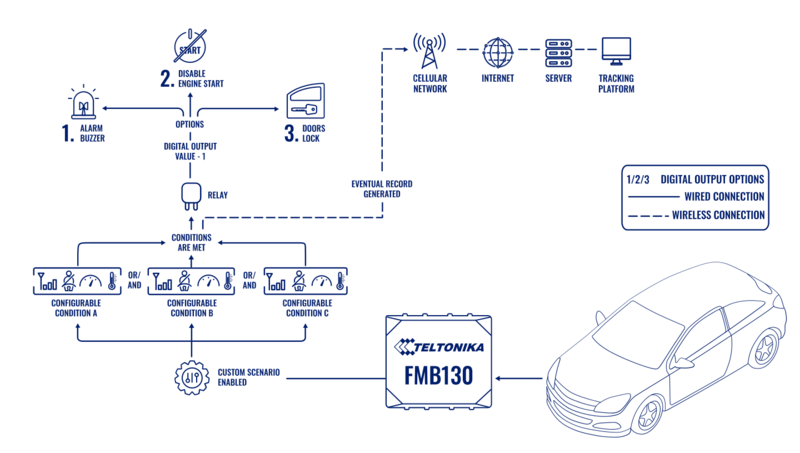Custom Scenarios
Introduction to Custom Scenarios functionality
To meet the diverse and evolving needs of our clients, we have developed the Custom Scenarios feature. This solution allows users to define specific conditions using customizable parameters to trigger events or control a device’s digital outputs. By connecting the device to peripherals like alarms, buzzers, or relays, this functionality can notify drivers or perform targeted actions seamlessly.
The feature enables the device to operate autonomously based on predefined conditions, eliminating the need for constant monitoring of device status or complex backend integrations. With Custom Scenarios, any data the device can read becomes a potential input for controlling digital outputs, providing flexibility and efficiency.
Custom Scenarios functionality logic
The Custom Scenarios functionality enables configuration of up to three independent scenarios, each with up to three unique triggers. Triggers are defined using data from various I/O elements, such as: Fuel Level, Engine RPM, Seatbelt Status, DTC Faults, Movement Status, Ignition State, GSM Signal Level, 1-Wire/Bluetooth sensor temperature and etc. Each trigger is configured with specific logic operands (e.g., "On Entrance," "On Exit"), threshold values (Low and High levels), and an activation delay timer, which specifies how long a value must remain within the defined range before the trigger is activated.
When all triggers of a scenario evaluate as true, the scenario becomes active. This can generate a record (if configured) and control the digital output (DOUT) by toggling it on or off based on the active conditions. Additionally, if configured for continuous operation, the DOUT remains active as long as the conditions are met.
Key features include:
- Support for dynamic trigger logic based on selected operands and conditions.
- Autonomous device operation, even in low-power or deep-sleep modes, provided compatible I/O sources are used.
- Adjustable ON/OFF durations or permanent output control, enabling versatile device behaviors such as blinking or continuous activation.
- Custom Scenarios operate independently from the I/O menu, with priority management ensuring that higher-priority scenarios take precedence in controlling the DOUT when multiple scenarios are configured.
Custom Scenarios functionality configuration
Below is a detailed explanation of configurable parameters for each scenario.
| Parameter ID | Parameter Name | Value Range | Default Value | Description |
|---|---|---|---|---|
| 19100, 19130, 19160 | Output Control | 0–3 | 0 | Determines which DOUT is controlled:
|
| 19101, 19131, 19161 | Priority | 0–3 | 0 | Sets the priority level:
|
| 19124, 19154, 19184 | Permanent Output Control | 0–1 | 0 | Keeps the DOUT ON while the scenario is active, ignoring ON/OFF durations. |
| 19102, 19132, 19162 | DOUT ON Duration | 100–65,000,000 ms | 200 ms | Defines the duration DOUT remains ON when activated. |
| 19103, 19133, 19163 | DOUT OFF Duration | 0–65,000,000 ms | 200 ms | Defines the duration DOUT remains OFF for blinking behavior. |
| 19105, 19135, 19165 | Source | I/O Element ID | N/A | Specifies the I/O source to monitor (e.g., fuel level, ignition). |
| 19106, 19136, 19166 | Operand | 0–6 | 0 | Determines the evaluation logic for source values:
|
| 19107, 19137, 19167 | Low Level | Dynamic | 0 | Sets the lower threshold for source trigger activation. |
| 19108, 19138, 19168 | High Level | Dynamic | 0 | Sets the upper threshold for source trigger activation. |
| 19109, 19139, 19169 | Activation Delay Timer | 0–65,535 s | 0 | Time the condition must be true before the trigger activates. |
| 19115, 19145, 19175 | Logic | 0–1 | 1 | Determines how triggers are evaluated:
|
Configuration Steps
1. **Define Output Control**:
- Select the DOUT to be controlled when the scenario is active.
2. **Set Triggers**:
- Configure up to three sources, each with unique thresholds, operands, and delay timers. - Sources must differ for each scenario.
3. **Configure Timing**:
- Set DOUT ON and OFF durations or enable Permanent Output Control for continuous activation.
4. **Save Settings**:
- Verify the configuration and save. The device evaluates all scenarios every second.
Operational Details
- Scenarios are evaluated every second. When all triggers are true:
- The scenario activates, toggling the DOUT and optionally creating a record.
- Deep sleep compatibility: Scenarios operate in low-power modes if sources support it. - Priority management ensures higher-priority scenarios override lower-priority ones for DOUT control.
Example Applications
- Activating an alarm if RPM exceeds a threshold while the ignition is on. - Triggering a relay when the fuel level drops below a critical point. - Enabling a buzzer for temperature out-of-range conditions.
